mission: Technology
News . Events Mobile Tools for Combating Slave Labor – SDG 8
Context
The Center for Combating Slave Labor and Human Trafficking (CETE) is based at UNEB Campus XVI in Irecê under the leadership of Prof. Dr. Ana Karine Loula Torres Rocha and her team including Prof. Ms. José Allankardec Fernandes Rodrigues and Prof. Dr. José Humberto da Silva (consultor). A key collaborator is UNEB’s Salvador campus, represented by Prof. Dr. Silvar Ferreira Ribeiro, Prof. Dr. Sônia Maria da Conceição Pinto, and Prof. Dr. Hebert Vieira Durães who coordinate open schooling initiatives. This initiative also receives support from UNEB’s Rector, Prof. Dr. Adriana dos Santos Marmori Lima, and benefits from international collaboration with the Open University UK, represented by Dr. Alexandra Okada.
In alignment with the UN’s Sustainable Development Goals (SDGs), particularly SDG 8 (Decent Work and Economic Growth), CETE utilizes open education and open schooling including mobile technologies to promote economic growth, inclusive and sustainable employment, and decent work for all, as well as SDG 4 (Quality Education). The Brazilian Constitution of 1988 affirms work as a social right, ensuring dignity and social protection for workers. However, many still face exploitative working conditions; slave labour remains a criminal offense under Article 149 of the Brazilian Penal Code.
Education and Social Inclusion as a Strategy for Preventing Slave Labor
In this context, CETE was created, the first clinic in the Northeast with this focus, as a proposal to confront this reality; within it, we commit to our political, scientific, and social vocation based on the relationship between UNIVERSITY – TERRITORY – DEVELOPMENT from the perspective of sustainability, science, technology, and innovation with social responsibility and open schooling. Supported by the CARE-KNOW-DO framework, one of the initial challenges of this project is to engage adult learners in reflecting on the local context, contributing to raising awareness of the condition of slave labor.
As a strategy to confront this issue, it is necessary to strengthen the interdisciplinary support network, integrating areas such as education, law, and health, in pursuit of actions promoting decent work and protecting human rights in the workforce, prioritizing vulnerable individuals and communities, promoting equal opportunities, and proposing regional and local development strategies that foster community bonds and inclusive, sustainable economic growth.
Among the activities already developed by the University of the State of Bahia in teaching, research, and outreach is its strong connection with public basic education schools, directly interacting with administrators, teachers, students, and their families. Youth and Adult Education (EJA), one of these fields, targets individuals who missed regular schooling, comprising a group of men and women, workers who, as verified, fit the profile of those recruited for seasonal farm work. Focusing on these individuals can be a relevant strategy to prepare them to face this harsh reality. Educating, raising awareness, preventing, and training for more skilled jobs can certainly help reduce their vulnerability, preventing recruitment into this illegal activity.
The Connect 2030 Project, already underway in the region in the cities of Ibipeba, Lapão, Irecê, and Presidente Dutra, supports this process by delivering science education based on real socio-scientific issues, involving families, other societal segments, university scientists, and policymakers, contributing over the past three years to improve local education and projects for expansion and consolidation of its results.
Today, CETE is part of a network of legal clinics in Brazil addressing slave labor and human trafficking, including:
- Slave Labor and Human Trafficking Clinic at the UFMG Law School / MG;
- CETE: Anti-Slave Labor Clinic at UNEB / BA;
- Human Trafficking and Slave Labor Clinic at João Pessoa University Center – UNIPÊ / PE;
- CETE – Anti-Slave Labor Clinic – UFU Law School / Uberlândia / MG;
- Slave Labor Combat Clinic (CCTE) – UFPA / PA;
- Exploitative Labor Combat Clinic (CCST) – UFBA / BA;
- Slave Labor Clinic UNIFACIG / MG;
- Slave Labor Combat Clinic UNIPAC – Uberaba / MG;
- Human Rights Clinic at UFMT / MT.
CARE:
This open education community supported by open schooling highlights the following project goals:
- Support and strengthen actions promoting Decent Work, developed by the public sector, social organizations, and private sector in the Irecê region;
- Implement strategies promoting decent work with the protection of human rights in the workforce, prioritizing vulnerable individuals and communities, promoting equal opportunities, and proposing a regional and local development strategy capable of strengthening community bonds and fostering inclusive, sustainable economic growth;
- Develop actions through social dialogue for mutual collaboration, respect, institutional capacities, and concrete actions, acting individually and collectively to promote decent work in the region, aiming at building a Network for Promoting Decent Work;
- Undertake preventive, intervention, and follow-up actions for individuals who are victims of slave labor and human trafficking across various fields such as education, law, and health.
KNOW:
According to recent research, SmartLab 2023, in Brazil, among victims of slave labor, 64% are Black, with many having low levels of schooling, and most rescued victims are male (93%). In Bahia, Black individuals represent 80% of those rescued, with more than half not completing the 5th grade, and among them, 22% are illiterate. The majority are male (92%) and between 18-29 years old. Research by the Federal University of Minas Gerais (UFMG) identified that Irecê / Bahia / Brazil has the highest percentage of modern enslaved individuals on coffee farms in Minas Gerais. Victims of contemporary slave labor and human trafficking are in a situation of grave social and emotional vulnerability.
Through research conducted by the Federal University of Minas Gerais – UFMG, between 2002 and 2022, it was identified that the region of Irecê / Bahia / Brazil had the highest percentage of modern enslaved individuals on coffee plantations in the State of Minas Gerais: 420 individuals. Victims of human trafficking for purposes of labor analogous to slavery, by the end of July 2024, in the interior of MG, on coffee farms, totaled 46, with these numbers: São Gabriel (06) / Lapão (03) / Mirangaba (01) / Canarana (13) / Irecê (01) / Morro do Chapéu (03) / Jussara (14) / Ourolândia (02) / Cafarnaum (03); at the end of August 2024, in the Federal District, at Grupo Pluma farms, an additional 10 individuals were counted: Xique-Xique (06) / Nova Ibiá (02) / Bonito (02). All these people, victims of contemporary slavery and human trafficking, are in a situation of severe social and emotional vulnerability.
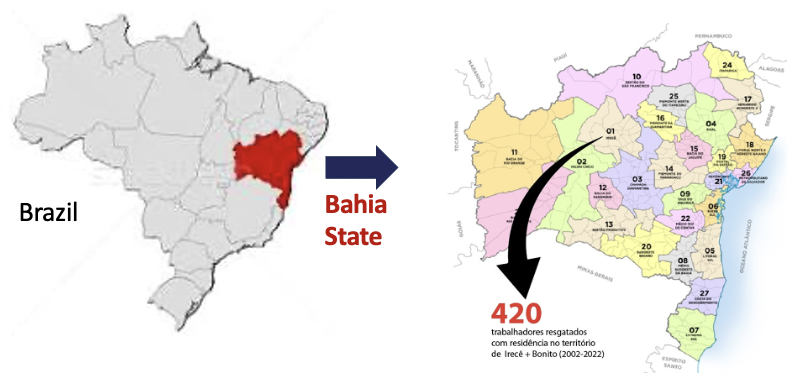
DO:
Working Groups:
- Guidance / Legal support;
- Psychosocial health;
- Scientific Studies and Communication;
- Responsible Research and Innovation;
- Open Education with Open Schooling supported by STEAM and e-artvism;
- Professional Training / Capacity Building.
Actions:
- Participation and Contribution to the I Regional Seminar in Irecê on Decent Work;
- Signing of a Commitment Agreement between UNEB and UFMG, in addition to the Regional Pact for Promoting Decent Work;
- CETE Itinerant;
- Creation of a Research Group registered with CNPq;
- Offering an elective course in undergraduate and graduate studies;
- Participatory Design of Resources, Technologies, and Pedagogies for Open Schooling to raise awareness, prevent, and empower through partnerships between schools, universities, and professional experts.
Partnerships:
- OAB; Junior Company – CONSOL; FAEB / SENAR;
- Secretariat of Labor, Employment, Income and Sport – SETRE;
- Decent Work Institute – ICT; Coffee Program;
- Global Fund to End Modern Slavery – GFEMS;
- Network of Legal Clinics in Brazil;
- Open University / UK.

Photo: CETE – at UNEB Campus XVI in Irecê
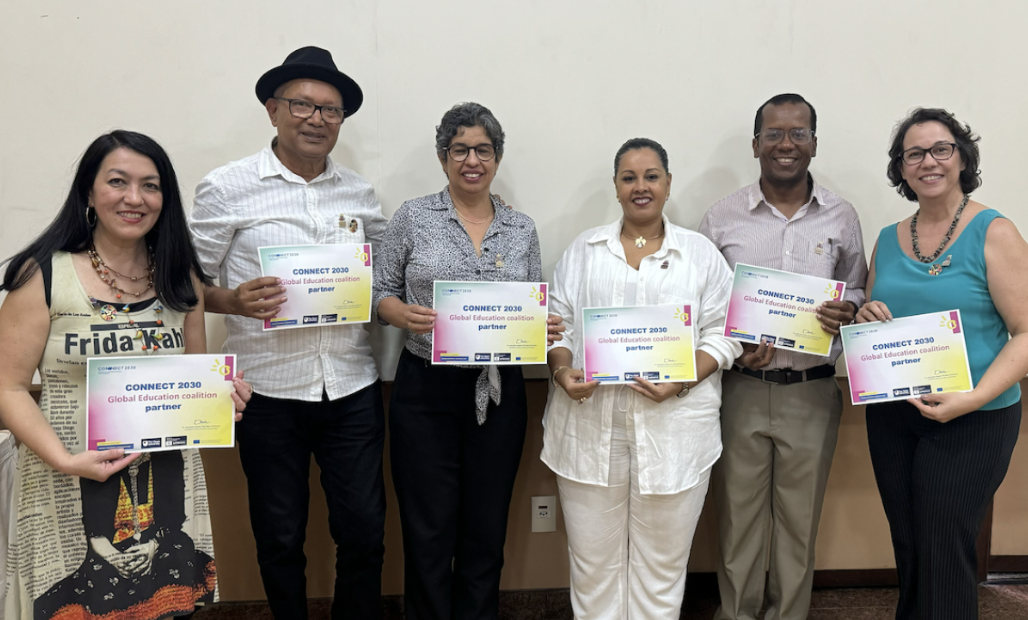
Photo: CETE – at UNEB Campus XVI in Salvador
The integration of e-artivism into the CETE initiative at UNEB demonstrates how art and activism can amplify awareness of human trafficking and slave labor, fostering community engagement and driving systemic change through open schooling. By creatively combining digital tools, storytelling, and visual media, e-artivism enables students, educators, and communities to confront the harsh realities of exploitative labor and human trafficking.
Through the CARE-KNOW-DO framework, e-artivism encourages emotional engagement (CARE) by using impactful narratives and visual campaigns that evoke empathy and understanding of victims’ realities. In the KNOW phase, participants engage in research and discussions, analyzing socio-scientific data on slavery and trafficking to deepen their knowledge and identify root causes. Finally, in the DO phase, e-artivism mobilizes communities to take action, such as creating educational resources, organizing awareness campaigns, and collaborating with local and national stakeholders to promote Decent Work (SDG 8).
This approach not only educates but also empowers individuals and communities to actively participate in combating exploitative practices. By embedding e-artivism into open schooling, CETE leverages the transformative potential of art and activism to create a culture of awareness, prevention, and advocacy, aligning with the principles of inclusive and sustainable development.
REFERENCES:
CETE website :
https://www.ceteunebirece.org/
Nossa voz:
https://nossavoz.org.br
Literature:
Freire, P. (1996). Pedagogy of the oppressed (revised). New York: Continuum, 356, 357-358.
Freire, P. (1998). Pedagogy of freedom: Ethics, democracy, and civic courage. Rowman & Littlefield.
Research in the news:
Starbucks: slave and child labour found at certified coffee farms in Minas Gerais
News . Events Audio Visual artefacts for communities (SDG 11)
Fonte:Imagem recorte do vídeo Trilhas da Pedagogia – Disponível: IFECast https://youtu.be/RUkKhuhl–0?si=bfo0PIcXU_QVDIzq
Context:
This practice was part of the training of undergraduates in the Pedagogy Course at the Federal University of Cariri (UFCA), which was recently recognized with the highest score by the Ministry of Education (MEC). The course stands out for its interdisciplinary work, through which educators promote teaching, research, outreach, and culture.
This partnership with the Porteiras School began in 2022, due to research developed in the open schooling axis with digital technologies, in the Pedagogy course and a national partnership linked to CNPQ in which UFCA is connected to studies at UFRJ, UFF, PUC-SP, PUC-PR, UNEB, UFSC, and internationally with the Open University, with studies by Alexandra Okada.
One of the first challenges for Pedagogy undergraduates and basic education students was to open their windows. This process encouraged students to reflect on their local context, to investigate the socio-scientific topics that most interested them. Several disciplines were integrated, from the fields of art, technology, and curriculum, as seen in one of the videos from the exhibition of photo-narratives created by Francione Charapa, at IFE/UFCA.
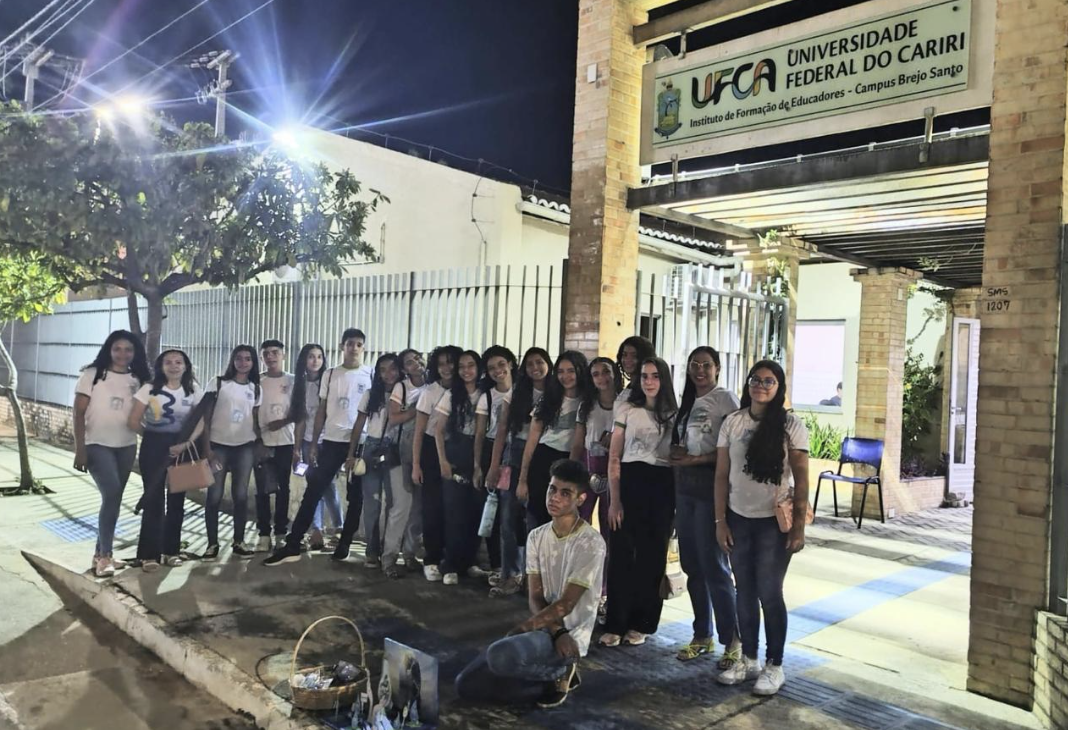
After this journey of opening the windows for pedagogy students, we implemented an action-research project coordinated by Prof. Dr. Karine Pinheiro at Cirene Maria Esmeraldo School, involving research scholars such as Daniel Alberto, Emerson Gomes, Valeria Vieira, Vivila de Carvalho, Elizete da Silva, Luana Argentina, Marielly, and 85 pedagogy students. At Cirene Maria Esmeraldo School (Kessyo Santos, Thais Coelho, Maria do Socorro Silva and the basic education students at Cirene Maria Esmeraldo School in Porteiras), and in the cultural community at the Quilombo do Souza, with Master Maria de Tiê, Cyda Olímpio, Valéria Pinheiro CIAVATA, and Instituto Anjos Digitais. The project continues with the coordination of university extension activities, with the Freirean Movement led by Prof. Darliane Amaral and the appreciation of multiple cultural expressions, which was also supported by the Voices of Cariri Project, led by Prof. Dr. Ligia Rodrigues.
This open schooling community highlights two examples that integrate the use of digital technologies to support the training of educators focused on creative processes through various digital genres, fostering open schooling:
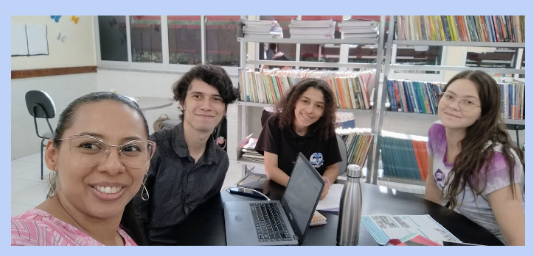
The first example was featured in the Teaching Initiation Program, particularly during the First Meeting of the Institutional Program of Teaching Initiation Scholarships (EnPibid/UFCA) and the First Meeting of the Pedagogical Residency Program (ERP/UFCA) at the Federal University of Cariri (UFCA). Approximately 20 papers were published by undergraduate students, who developed communication skills, teamwork, expanded vocabulary, and a decolonial perspective on the curriculum. As part of the intersectoral integration between the university and schools, 24 workshops and a thematic panel were developed in collaboration with the State University of Bahia (UNEB), alongside Professor Silvar Ribeiro. This connection reinforced the bond between the university, schools, and the community.
The second example refers to activities in a basic education school in the municipality of Porteiras, aimed at analyzing the educational projects developed by basic education students. These projects were aligned with the pillars of open schooling and the development of the C5 Generation (creative, critical, collaborative, communicative, and civic-minded). In both examples, literacy and scientific education were promoted from basic education onward, embedded within a cybercultural context, involving undergraduates, teachers, and students engaged in open schooling.
CARE:
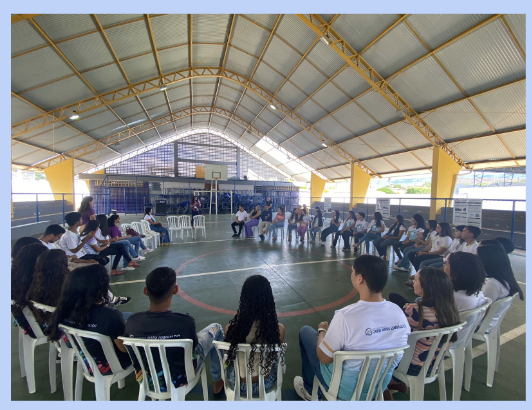
The undergraduate students in the Pedagogy Program at the Institute of Educator Training were involved in research, outreach, and cultural projects tied to real-life themes from their community. These activities occurred both at the university, with courses like Digital Technologies and Pedagogical Innovations, and in basic education schools. Guided by Professor Karine Pinheiro, these initiatives expanded research in basic education and established partnerships between schools, the community, and the third sector, focusing on the creation of school projects using the open schooling approach.
KNOW:
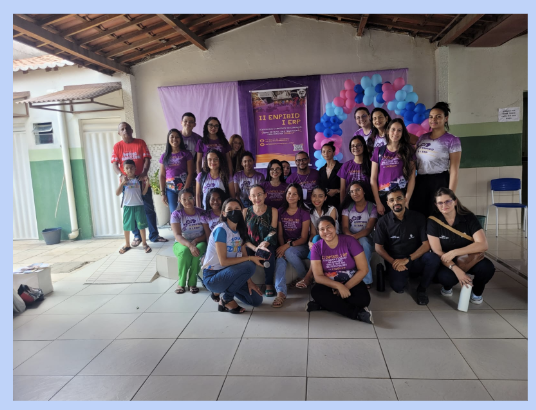
The project engaged digital natives (Prensky, 2010), who developed creative processes through new digital genres, experiencing the power of technology to express ideas in multiple forms. We observed a growing use of video, with students sharing stories, reels, and TikTok videos. Consequently, the cultural practice of using images was intensified with audiovisual production, marked by the multimodal nature of language in the cybercultural context (Santos, 2014). Through various disciplines, students experienced this new approach, incorporating fieldwork where they encountered popular, scientific, and cultural knowledge, all of which had unimaginable impacts on open schooling (Okada, 2016).
In addition, several workshops were designed to map concrete issues and geographic areas using Google Earth to identify locations, aiming for authentic co-learning.
DO:
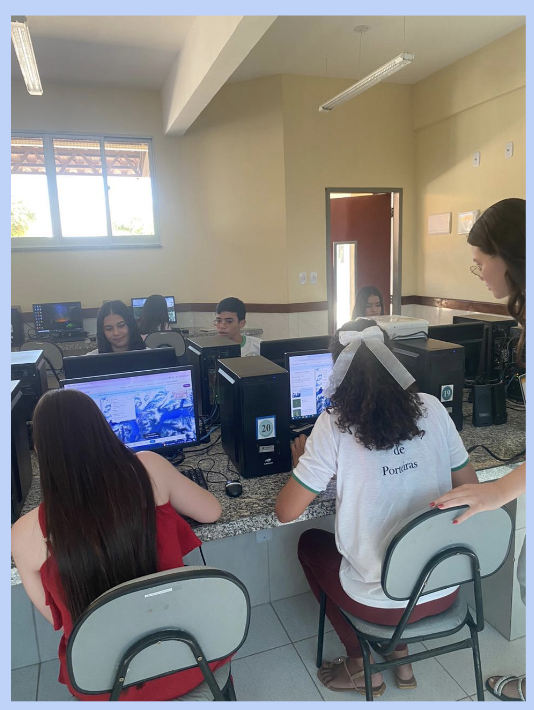
The educational projects developed by students during 2023-2024 involved multiple societal actors, reinforcing democratic practices, valuing diversity, promoting solidarity, and addressing environmental issues. These initiatives fostered autonomy, helping students become active citizens within their community. This process was grounded in the principles of open schooling for the development of scientific education, open access, public engagement, and governance.
Through these activities, students became cultural producers on themes such as solid waste, cultural heritage, water conservation, and animal protection. Another highlighted competence was the expansion of socio-scientific vision. Both basic education and university students presented their projects at scientific events. As a result of this study, we introduce a Podcast Channel with around 1,800 views, showcasing the active involvement of cultural practitioners, who became reflective producers and developed a situated practice through continuous debate. The impact of this activity at the UFCA Brejo Santo campus became “glocal” (Silva, 2005).
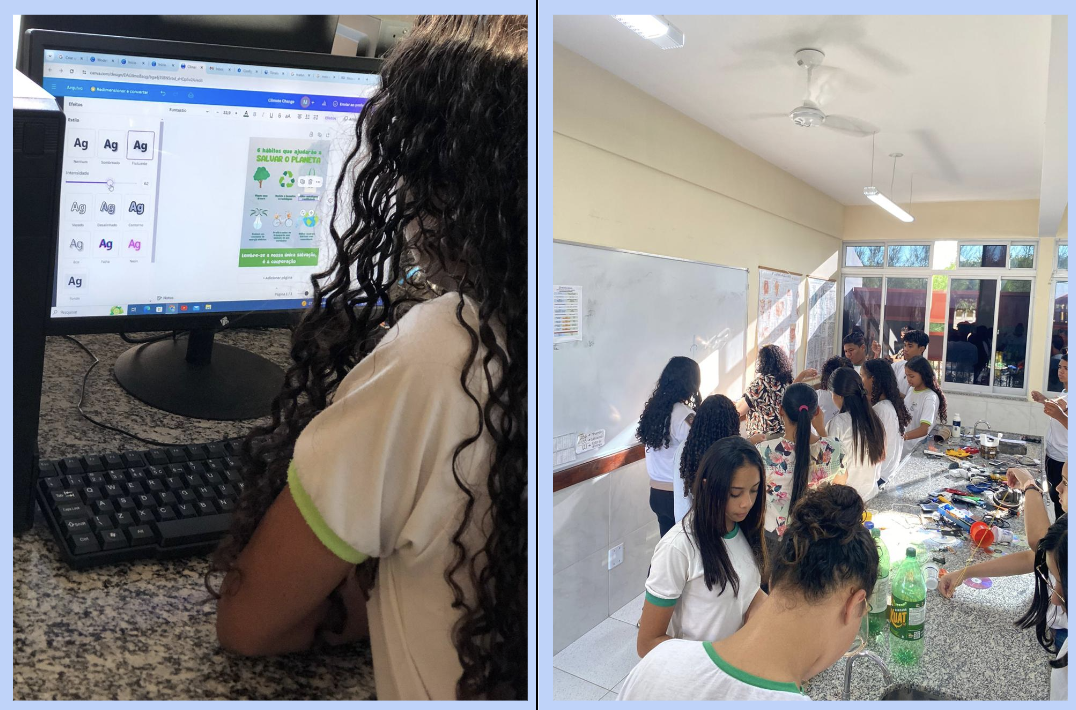
Image – Recycling Workshop and Selective Waste Collection Campaign
Source: Produced by the authors
Results from Teachers (Six basic education teachers from Cirene Maria Esmeraldo Municipal School):
Pedagogical innovation using real, relevant contexts for students related to:
- SDG 15 – Animal protection, solid waste management
- SDG 4 – Cultural heritage
- SDG 16 – Water conservation
Publication of 14 scientific papers: ENPIBID/2023, IV Biology Meeting (IFE/UFCA).
Results from Undergraduate Students – Pedagogy (85 students) and Basic Education Students (Municipality of Porteiras):
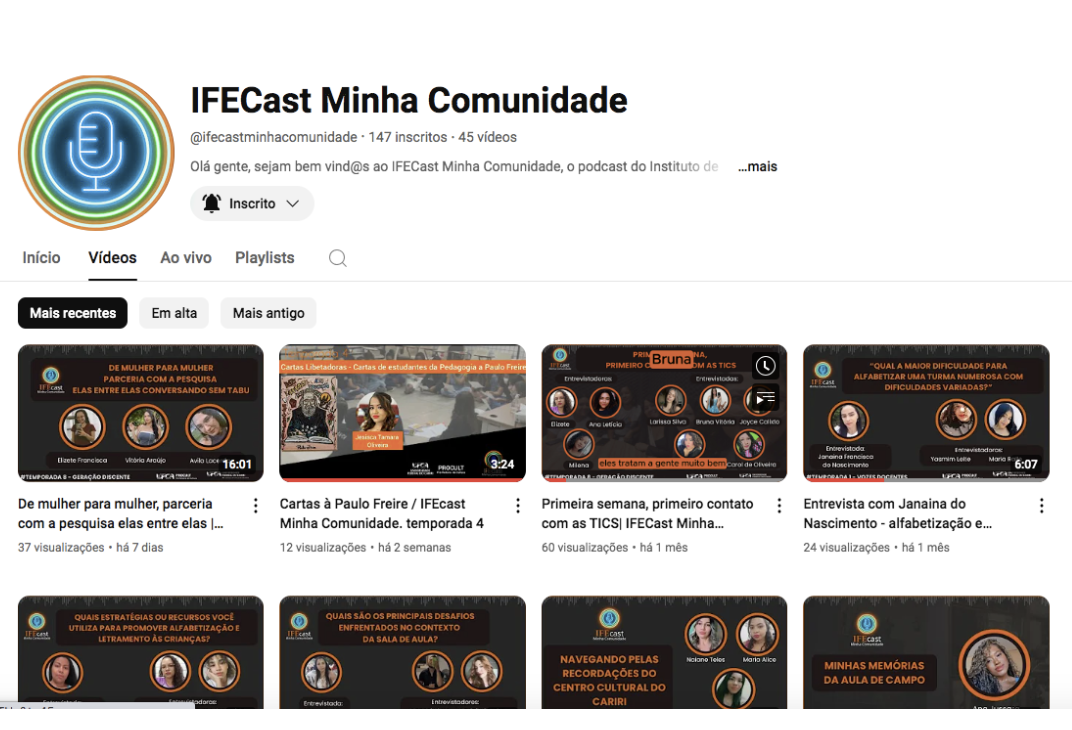
Creation of an educational device – IFECast: My Community, a project involving interdisciplinary undergraduates and pedagogy students. The project involved various pedagogical moments for engagement within the IFE/UFCA community, through open schooling, exploring identity, meaning, and practice. This was facilitated by problematizing their reality.
We share the channel for this C5 Generation of Co-Entrepreneurs – IFECast: My Community, featuring audiovisual narratives about field visits to quilombola communities, environmental trail discoveries, storytelling creation, photo-narrative exhibitions, and interviews that inspired teaching discoveries through diverse digital genres. About 45 videos are available at: YouTube Channel: IFECast: My Community and on Instagram at: @ifecast_ufca.
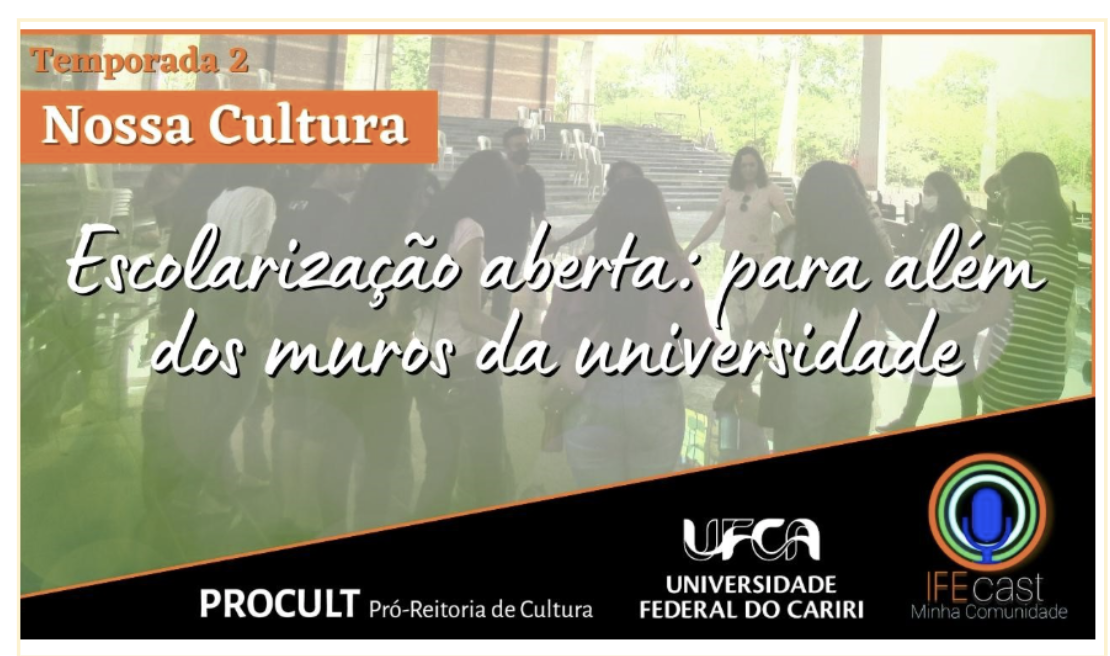
News . Events AR for Health (SDG3)
The central idea of the activity was to spark students’ curiosity by using news stories to connect science content to everyday life. The goal was for students to understand the relationship between the nervous system and the impact of psychoactive substances on the body, promoting greater interaction with their families and extending reflection beyond the classroom. Additionally, students were encouraged to engage with scientists to foster interest in pursuing STEM or science-related careers.
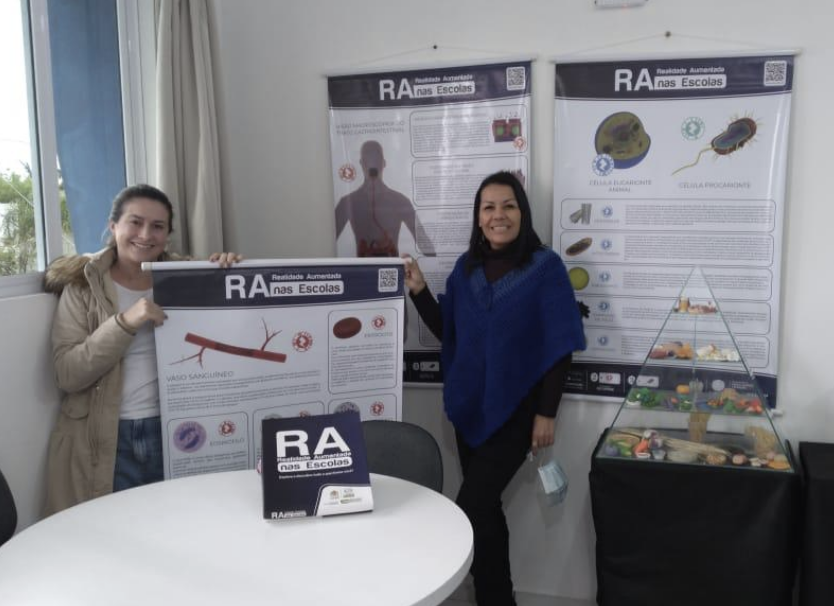
As part of the activities, teachers were given suggestions aligned with the National Common Curricular Base (BNCC), specifically for the 6th grade, within the thematic unit “Life and Evolution.” Among the suggested skills, students worked on explaining the functioning of the nervous system and how it can be affected by psychoactive substances (EF06CI10), as well as justifying the role of the nervous system in coordinating motor and sensory actions based on its structures (EF06CI07).
Throughout the project, teachers had the freedom to apply Augmented Reality (AR) cards as they saw fit, promoting a dynamic and tailored exploration of the content for the students.
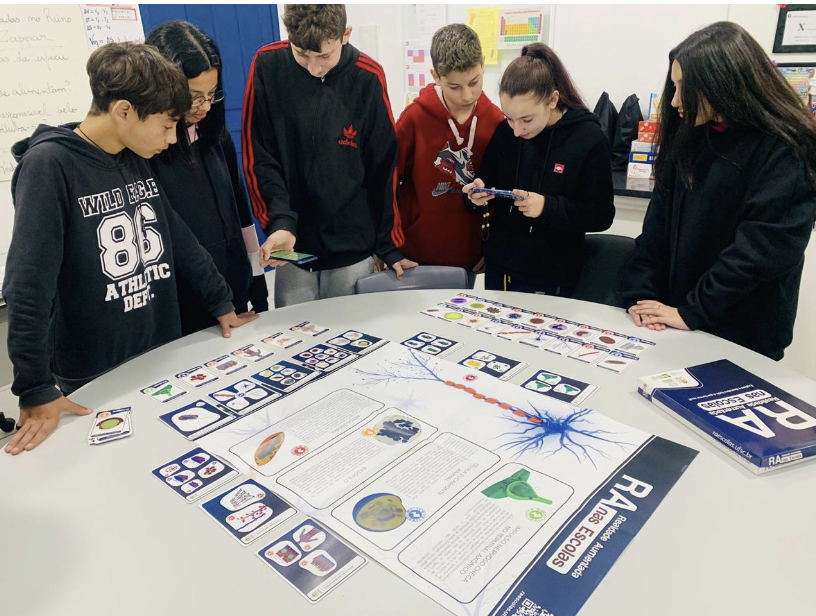
The students participated in a series of activities in three distinct phases, aiming to explore the functioning of the nervous system and the impact of psychoactive substances on the body using AR technologies and interactions with scientists.
– CARE: Students were encouraged to care about everyday issues raised by a news story related to the use of psychoactive substances. They explored how the nervous system can be affected by these substances using AR cards to visualize neurons, axons, and dendrites. This phase piqued students’ curiosity and motivated a deeper exploration of the content.
– KNOW: Students discussed the role of the nervous system in coordinating motor and sensory actions of the body. They also addressed how science can clarify the damage caused to the body by psychoactive substances and discussed the social impacts of substance consumption. The class listed the main problems related to the topic, broadening their understanding of the associated risks.
– DO: Students were encouraged to take the knowledge they acquired to their families. They were tasked with discussing the subject at home and bringing questions and curiosities to the scientists. Families also proposed actions to combat the problems identified in the previous phase, and students brought these ideas back to the classroom in the following session.
In the **Closing** phase, students watched a video with a guest scientist who answered their questions and explained how knowledge of the nervous system is related to their field of expertise. This brought students closer to scientific practice and stimulated their interest in scientific careers. After the video, students completed a questionnaire about the activities and the knowledge they had gained.
Teacher Training: A 60-hour course trained 1,000 public school teachers across Brazil in using augmented reality (AR) content in the classroom. The activities aimed to engage students with real-world questions and problems, encouraging them to explore and acquire knowledge through reflection with AR, as well as through practical actions involving the community and family. These discussions extended beyond the school environment, adhering to the principles of open schooling.
Project Focus: The project centred on:
- Effective Learning: Promoting digital AR skills through exploration, visualisation, discussion, and visual comprehension.
- Inclusion, Equity, and Gender Equality: Enhancing multi-literacy for both youth and adults.
All content aligned with the subjects teachers already cover in class, but with an open schooling approach—addressing real-world issues relevant to students and applying this knowledge in the community.
Safe and Inclusive Learning Environments: Teachers reported that the project significantly enhanced learning environments by offering engaging, immersive, and innovative digital content. Promoting science through digital education aligned with new teaching methodologies for future generations. The project gained recognition from Brazil’s Ministry of Science, Technology, and Innovation.
Recently, President Lula signed the National Digital Education Plan into law. The AR project in schools represents a major contribution to promoting open science, aligning its content with the National Digital Education Plan and the National Common Core Curriculum (BNC
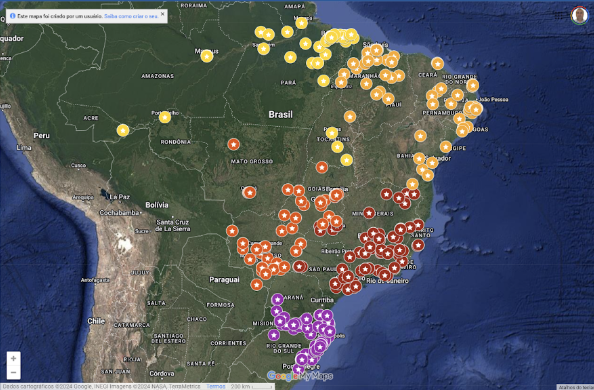
**Teaching Results**
The results showed varying levels of teacher confidence regarding the activities:
1. **Small Group Discussions (A08)**: 83% of teachers felt confident.
2. **Use of Questions for Divergent Thinking (A07)**: 76% of teachers felt confident.
3. **Interaction with Researchers and Scientists (A05)**: 71% of teachers felt confident.
4. **Encouraging Participation in Science Activities Outside School (A04)**: 71% of teachers felt confident.
5. **Promoting Discussions on Science and Society (A02) & Helping Generate Evidence-Based Questions (A03)**: Over 70% of teachers felt confident.
6. **Teaching Scientific Inquiry with Real-World Problems (A01)**: 65% of teachers felt confident.
7. **Encouraging Discussion of Scientific Topics with Family (A06)**: 66% of teachers felt confident, with 24% feeling less confident.
In all activities, only a small percentage (less than 5%) felt very unsure.
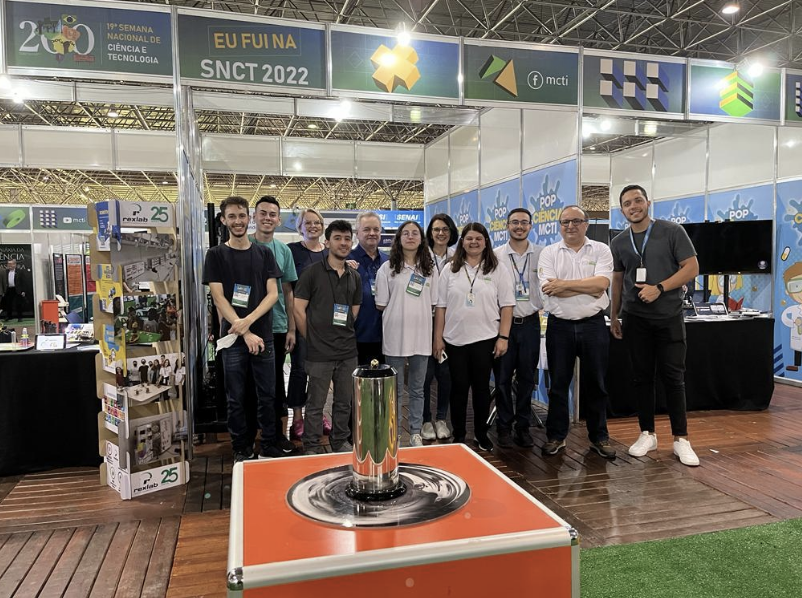
**Learning Outcomes**
Students generally demonstrate a positive attitude toward science and its importance. The vast majority (82%) agree or strongly agree that learning science will be useful in their daily lives. Even more (86%) recognize the importance of science, technology, and mathematics for problem-solving.
There is a strong belief (87%) among students that science helps people worldwide lead pleasant and healthy lives, indicating an understanding of science’s global impact.
However, when it comes to personal confidence in science, the results are more mixed. Only about a third of students (31%) feel confident in their science knowledge, with a similar proportion (31%) feeling confident using mathematics to solve scientific problems. Slightly more students (42%) feel confident using science to generate questions and ideas.
Students show more confidence in their ability to justify views using arguments and evidence, with 43% feeling confident in this area. This suggests that while they may not feel as confident in their scientific knowledge, they have developed some critical thinking skills.
Regarding practical application, nearly half of the students (48%) feel confident in doing science projects with colleagues, family, and scientists. A similar proportion (49%) feel confident talking about science, indicating a willingness to engage with scientific topics.
Encouragingly, the vast majority (80%) of students express interest in doing projects with others using science, suggesting a desire for collaborative, hands-on learning experiences in science.
When it comes to enjoyment and future aspirations, 57% of students find learning science fun. However, opinions are more divided on career prospects, with 42% interested in a job that uses science, and 37% aspiring to be seen as experts in science. These results highlight the importance of integrating engaging pedagogies with the meaningful use of AR for immersive learning across all areas, supporting sustainability goals.
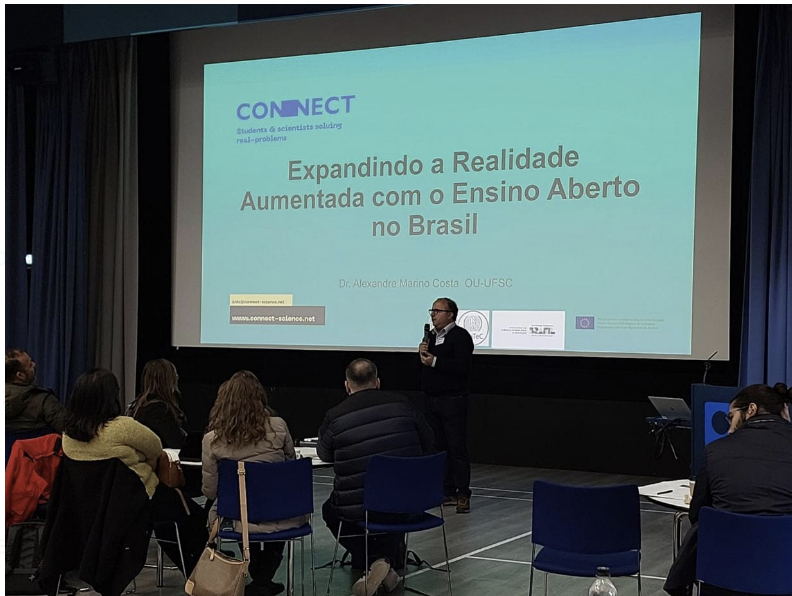
Overall, while students generally recognize the importance and value of science, there is room for improvement in building their confidence and skills in scientific practices. The data suggests that hands-on, collaborative approaches to science education might be particularly well-received by students.
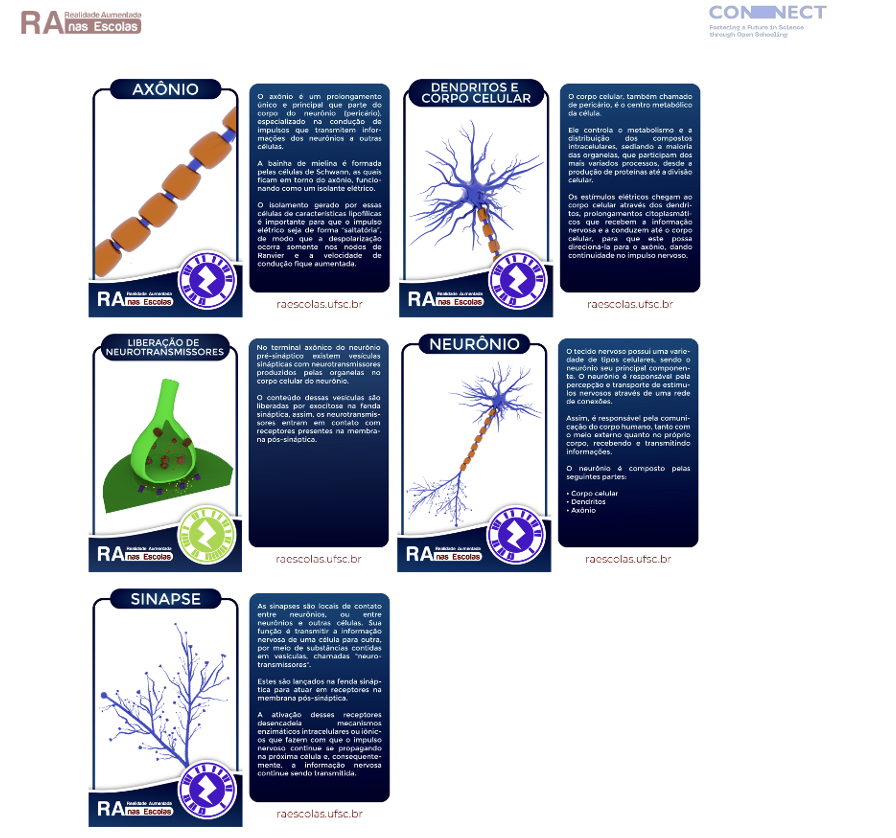
E-artivism played a central role in bridging scientific content with artistic and technological expression. The use of AR cards to visualize the nervous system and the effects of psychoactive substances brought abstract scientific concepts to life in vivid, accessible ways. This approach aligns artistic tools to transcend traditional barriers, making complex ideas more relatable and fostering curiosity. Students were not only learning science but also co-creating visual representations that connected their knowledge to broader social and environmental themes.
The CARE-KNOW-DO framework further supported this e-artivism approach. In the CARE phase, AR visuals sparked students’ curiosity and encouraged them to explore how psychoactive substances impact the nervous system, creating a personal and emotional connection to the topic. The KNOW phase fostered deeper understanding through discussions about the role of the nervous system and the broader societal implications of substance use. Finally, the DO phase transformed this knowledge into action, as students extended their reflections to their families and communities, proposing tangible solutions to combat the issues identified.
Through collaborative activities, such as interacting with scientists and creating evidence-based questions, students became active participants in scientific inquiry and advocacy. These experiences embody the principles of e-artivism by merging technology, creativity, and activism to address real-world challenges in meaningful and engaging ways.
By linking science education with e-artivism, this initiative helped students become confident, collaborative, and creative learners who see science as a tool for positive societal change. The immersive and interactive approach not only improved their understanding of scientific concepts but also encouraged them to take ownership of their learning and apply it to real-world contexts, reinforcing the transformative potential of e-artivism in fostering sustainable development.
Links:
Results
[00:12, 04/10/2024] Students
[01:16, 04/10/2024] Teachers https://openeducation.eu.qualtrics.com/reports/public/b3BlbmVkdWNhdGlvbi02NDc3ZTY1M2IyYTU4MjAwMDhlYjZhODMtVVJfYnlMM3lKSFY0YlBxUkhE
News . Events Discovering the natural wealth of the White Mountains using ICT
Care: The students were engaged in recording and studying the threats and risks facing our Ecosystems and in particular the White Mountains National Park. The students who participated in the activities were 10 years old and went to Primary D. There were two sections and a total of 35 students participated in the program.
Know: The skills the students practiced was to explore the Samaria Gorge through ICT. The students initially dealt with understanding how to read, orient and process a digital map (GIS) as well as the possibilities of GPS. With the help of electronic files received from the Samaria National Forest Management Body and the use of the Google Earth computer application, they managed to see the path of the canyon but also to learn how to read and orient a map. Also through the Geogreece website they found information about the flora and fauna of our country, the National Forests and the habitats that exist. From the information they collected each group proposed 3 questions and thus each department made a Quiz.
To create the quiz they used the kahoot application. Then they visited the Spatial Information Systems laboratory of the Technical University of Crete. There they were welcomed by the professor and head of the laboratory, Mr. Partcinevelos Panagiotis, where, together with his research team, he guided them around the premises of the laboratory and together they discussed the use of IT systems in the representation of maps, as well as automatic geo-location systems (GPS ). In particular, they saw how they can use drones with built-in GPS to prevent fires and other natural disasters as well as to rescue people in the Samaria gorge. They also created a real relief map of the Samaria area using the Sandmap tool.
Do: At the end, the students prepared a model of the Samaria gorge and the Portes point in comparison. Then they built a fire alarm mechanism using the Arduino microcontroller. This mechanism was designed and programmed through the tinkercad application with the help of the students of the third grade of the school. Thus they completed the activities as a group and supported by their family and the school’s High School. The presentation of their work took place at the Connect Student Conference on May 21, 2022. Conclusions about Open Schooling:
The activity was integrated into the curriculum. It was a challenge since, on the one hand, the Informatics, Artistic and Laboratory Skills courses had to be combined and all this in
collaboration with the scientific community. Open schooling can be useful for other teachers because the pedagogical use of ICT transforms traditional teaching practices and enhances the active involvement of students in all phases of the teaching process. The participation of scientists in this process did not confuse the students but helped them to deepen the topic they studied.
The change/innovation was supported by:
[ x ] School management [ x ] school association/network
[ x ] Local government [ ] Other: ________________________________
Student results: The students saw the program positively, they were excited by the use of technological means in every phase of the program and they participated very actively in it. Concerns were raised regarding the dangers and threats facing our ecosystems, but they were particularly encouraged by both their proposal to deal with fires through an electronic self-construction and the fact that there are scientists working on their protection.
This practice contributed to the increase of:
[ x ] engaging families with sciences [ x ] involving girls in science [ x ] raising awareness among students about careers in the natural sciences
Please specify: The students interacted with technological tools and applications in order to learn and understand their usefulness.
News . Events I capture through photography the problems of my place and apply solutions
Care: The planet is facing many problems of different kinds. But often we need to start with the simple problems of our community in order to find sustainable solutions that will last. In this way, we become familiar with the ‘culture of active citizenship’, learn to find solutions, implement them and take a keen interest in our neighbourhood. Every neighbourhood has its own problems, which often apply to the wider context of our city. Thus, the 16 pupils of E2 class of our school decided to deal with the problems of their neighbourhood.
Know: The educational scenario “I capture through photography the problems of my place and implement solutions” aimed to motivate students to connect their knowledge about light, to use the tool of photography, to depict problems of their wider neighbourhood and then, to find solutions, to implement and show them in the form of a multimodal installation.
Do: The students photographed the various problems in their neighbourhood, grouped them together and then found solutions for each one. In particular, they contacted the city’s kennel, interviewed volunteers and in consultation with them collected food for the strays. They then sent a letter to the town hall secretary citing problems with the sidewalk, trash and some large trees in the area. Finally, they made their own leaflets about illegal parking and distributed them in the area. They also made and placed recycling bins in various places (outside the school).
Conclusions on Open Schooling: This project opened the classroom to the local community. The students looked forward to doing the project at different times of the day, as everything they made, wrote and created had a direct impact on their daily lives and was characterized by an actual and concrete “meaning”.
The contact with scientists and community stakeholders was particularly helpful and gave the children added interest.
The change/innovation was supported by:
[ x ] School management [ x ] school association/network
[ x ] Local government [ ] Other: ________________________________
Student results: The students organized a multimodal installation in the classroom and presented in various forms what they did through the project. They made artworks, games, added sound and image to their thoughts and actions. The exhibition seemed “fantastic”, “special” and “interesting” as the visiting parents described it.
This practice contributed to the increase of: the Director of 41th Primary school of Heraklion [ x ] engaging families with sciences [ x ] involving girls in science [ x ] raising awareness among students about careers in the natural sciences
Please specify: All students participated and cooperated. The result was very encouraging for all of us. Girls and boys found motivation and interest in the activities. Parents were delighted with the enthusiasm of their children and worked very well together.
News . Events Landscape and Renewable Energy Sources (RES)
Care: The students dealt with the issue of the integration of RES in the landscape, a real problem that occupied the students of Tinos in view of the massive installation of wind turbines in the landscape of Tinos. The students who participated in the activities were twenty-eight (28), 14-year-old students of the 2nd Class of the High School.
Know: The students used knowledge about the role and importance of RES considering their rational integration in landscapes and ecosystems, considering their functions and value.
The skills the students practiced were:
- question processing,
- data analysis,
- discussion of claims and evidence,
- drawing or drawing conclusions,
- familiarity with the ways and stages of conducting a research,
- familiarity with techniques for searching, evaluating and presenting information through a variety of sources,
- development of collaboration, creative expression and presentation skills.
Do: At the end, students put their knowledge into practice by doing field research. A 2-day Educational Visit was made to the landscape of the paths of Andros (in collaboration with KPE Korthiou). The program of the visit included group work in and outside the field, namely: Practical-Experiential Part: hiking, information, observation, photography, exploration and activities, landscape experience with all the senses.
In detail, the practical-experiential part contained:
- Observation and recording of field characteristics
- Familiarity with the space through all the senses
- Perception of space through various games
- Identification of species of flora (mainly) and fauna
- Map reading
- Completing worksheets
- Presentation of the habitats of Andros and the most important historical stations
- Discussion about the needs of the people who created the landscape of Andros.
Creative Part: recording of valuable elements and problems of the landscape and ecosystem, discussion related to threats and proposals for better management. The result was a group presentation of the results of all work groups through a powerpoint work, which was presented by student representatives at an event organized by the High School of Tinos at the Spiritual Center of the Holy Foundation of Evangelistria on Thursday 25 May 2022 at 19.00, in which they took part and their parents/guardians. The presentation emerged from the discussions with the scientists in the context of the “learn” section and from the practical-experiential part of the training which included filling in worksheets (of the KPE), individual notes and group discussions.
The parents/guardians of the students who participated in the CONNECT program were informed about its content both in person (those who visited the school) and electronically with frequent messages describing the activities. This ensured as active an involvement as possible them in the whole project (a fact that helped to cultivate the scientific capital). The results of their program were presented extensively at a live event organized by the school.
Conclusions on Open Schooling: The action was not embedded in the curriculum, but indirectly related to it. It was useful and innovative as it related to the development of knowledge, skills and attitudes (as discussed below). Open schooling can also be useful for other teachers because it can combine knowledge and apply it in the field (eg identifying and valuing natural and cultural wealth of an area)..
The change/innovation was supported by:
[ x ] School management [ ] school association/network [ ] Local government [ ] Other: ________________________________
Student results: The students showed interest in the thematic subjects of the program, submitted questions and participated in discussions. They took into account what the scientists conveyed to them and a relationship of trust was cultivated. This was reflected in the results of the action. Notably, there were also examples of relatively weak students showing great interest in the collaborative method and field research and taking initiatives. They responded with particular enthusiasm to the educational visit (outside the island), which was an important motivation for their activation at all levels of thinking and action.
This practice contributed to the increase of:
[ ] engaging families with sciences [ x ] involving girls in science [ x ] raising awareness among students about careers in the natural sciences
Please specify: Parents participated in the collection of questionnaires for the student survey. The girls actively participated in the mapping and literature review and in general all students showed a special interest in digital maps and the contribution of geomorphological terrain to road construction.
News . Events Aerosol… hooked on! How do you control a ‘missing crown’?
- Care: In this phase, students’ curiosity and need to upgrade their knowledge level are stimulated, pre-existing ideas are explored and prior knowledge is activated. Interest and participation is fostered through real work based on a community problem, in this case the control of COVID-19 and ways to build a sensitive sensor device. The concerns and needs related to the problem are identified and the challenges to be investigated and the affected social actors to be involved are prioritized. To engage students by inviting them to participate in a participatory research project to develop strategies for the prevention and control of Covid-19 (and other similar infectious diseases) and also to consider how it is possible to build the study device themselves. They begin by first exploring their concerns and needs with their families and then prioritizing the challenges that need to be explored. The scenario is formed based on the need for more direct communication in the classrooms without losing the sense of security. The students who took part in the activities were 15-17 year olds who were studying at the Lyceum. A total of 35 students participated in the whole process.
- Know: This phase facilitates the acquisition of knowledge and the development of the scientific skills and attitudes required to address the issues under consideration. Students used knowledge of physics, chemistry and programming. The skills the students practiced were:
- To understand how to deal with a topic-challenge that they find interesting.
- To acquire research skills
- To understand that often in a given target problem there is a conflict of interests and to realize the existence of different approaches.
- Formulate proposals-recommendations to the citizens and agencies involved
- Well-informed discussion, communication, writing, interpretation, drawing and presenting conclusions based on knowledge
- Collaboration
- Do: In this phase, students applied the knowledge and skills acquired to develop the final product assigned to them. In this case, the final product was titled “Development of a sensitive CO2 sensor for the control and protection against viruses such as SARS-CoV-2 in closed spaces”. Studies and means of achievement were summarized and shared in an open letter. A school scientific conference was organized, where groups of students presented their work and proposals to the educational community. Representatives of policy makers and other relevant bodies were invited to the conference. The project was also presented at the 4th Panhellenic Scientific Conference P.D.E. Crete in May 2022.
Conclusions on Open Schooling: Community participation in the Connect-Horizon 2022 program discussed the vital role that education plays in preparing students to collaboratively address global challenges and local issues facing humanity today, such as global warming, climate change , environmental destruction, disease, inequality and violence. Students’ contact not only with teachers but also with scientists and policy makers makes them think together and learn science to address global and local problems.
The change/innovation was supported by: [ x ] School management [ x ] school association/network
[ x ] Local government [ ] Other: ________________________________
Student results: The purpose of this Project was to create the right conditions for the students to develop a scientific way of thinking in their daily life. Low cultural familiarity with science, lack of role models, insufficient exposure to experimental methods of inquiry, as well as limited opportunities to participate in science outside of formal education lead to a lack of “scientific capital”. The solution is to add more opportunities to the curriculum for these students to learn what scientists do, talk to their families about science, and appreciate the impact of science on the world. The satisfaction level of the children after the end of the project was great as they saw their efforts rewarded, they completed the construction successfully, they met many scientists with whom they solved several problems and they communicated their results with great joy at the CONNECT conference.
This practice contributed to the increase of:
[ x ] engaging families with sciences [ x ] involving girls in science [ x ] raising awareness among students about careers in the natural sciences
Please specify: Parents participated in the collection of questionnaires for the student survey. The girls actively participated in the mapping and literature review and in general all students showed a special interest in digital maps and the contribution of geomorphological terrain to road construction.
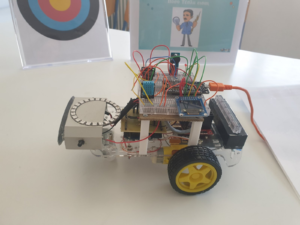
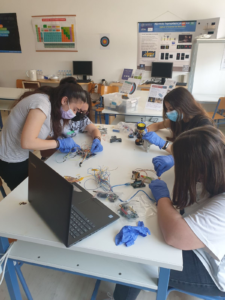
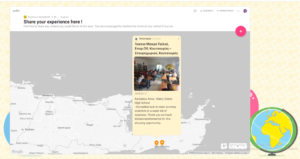
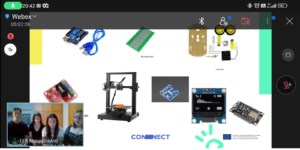
News . Events Memes and cartoons: Brazilian way in the Covid-19 pandemic (Best Practice Brazil)
CARE: The students were involved in the discussion about the COVID-19 contingency plan. The participants were 120 students, aged between 14 and 16, from the 1st grade of high school, 78 of whom completed the scientific action, with their families, a teacher, a researcher, and a scientist who shared their concerns about COVID-19 and ideas for creating memes and cartoons, to contextualize the Brazilian Federal Declaration with the pandemic, highlighting human and citizen rights and duties.
KNOW: They were developed, in an interdisciplinary and transdisciplinary way, with the school curriculum integrating the disciplines of Sociology and Philosophy in the analysis of historical and scientific data. Thus, it was possible to understand the laws that ensure the right of citizens in times of COVID-19, permeated by the concepts of Citizenship, Citizen, Cultural Identity and Declaration of the Rights of Man and Citizen, in view of the contingency plan proposed for the pandemic.
In the teaching and learning processes, the skills developed addressed the student’s ability to contextualize the rights of the citizen with the reality found in urban spaces with COVID-19, as well as the ability to interpret the laws and make them accessible to everyone who wants to know to improve their quality of life.
As for the attitudes to be developed, we sought to promote empathy to overcome the “chaos” caused by epidemics and pandemics; the appreciation of reflections on the Brazilian Federal Constitution for new approaches to knowledge, in addition to enabling new forms of learning emphasizing social relationships, ethics and respect for life.
DO: Students were involved in the following activities:
- Bibliographic research on the subject.
- Research in documentary sources and images.
- Analysis of scientific articles on the relationship between the declaration of human and citizen’s rights with the actions and attitudes of the population in the pandemic.
- Classroom debate on the Brazilian Federal Constitution.
- Preparation of pamphlets such as memes and cartoons about “how do people act today in the pandemic?” and “How should people act on COVID-19?”
- Socialization of visual production and reflections punctuated with an emphasis on the pandemic.
FINDINGS: The open scenario methodology used was project-based collaborative learning. Students brought their own questions, discussed with the scientists and their families. Teachers found the open teaching activity useful for the Contextualization of the Brazilian Federal Declaration with the pandemic highlighting human and citizen rights and duties. Teaching by area of knowledge facilitated the planning of actions, the applicability of learning activities, the use of technological resources and curricular interaction based on integrated projects.
OUTCOMES: The participation, engagement, and interest of students in the development of activities related to citizen rights in the COVID-19 pandemic. It was significant and surprising in the way they adhered to the proposal to know the Brazilian Federal Constitution. Most students did not know the rights of citizens. The relationship between legal laws and the pandemic was discussed with the students, arousing interest in knowing more and engaging in the activities of memes and cartoons presenting the Brazilian way in the pandemic. In a fun way, students were able to express their criticisms they felt about COVID-19.
During the learning activities, the students felt confident about their opinion on the rights of the citizen contextualized with the pandemic. Discussions about the Brazilian Federal Constitution aroused curiosity about the rights and duties of citizens defined by law. It is observed that the students were more confident in their speeches about Politics, Science and COVID-19.
However, the very social distancing generated by the pandemic period caused many disruptions in the school routine, among which they made it impossible to contact scientists or, in this case, jurists or political analysts. The return of face-to-face classes with 50% of the students, in the form of a rotation, reduced the time for carrying out the learning activities. On the other hand, some students were not included in the study for reasons.
Find out more here: Our report.
News . Events Climate change and pollution (Best Practice Greece)
CARE: The students successfully presented key questions for the continuation of the scenario.
KNOW: The main objective of the activity was to engage in a participatory research project to develop strategies for the prevention and control of Covid-19 (and other similar infectious diseases) and also to investigate how it is possible to build themselves a sensitive device to detect and study aerosols indoors using an Arduino microprocessor.
DO: The students prepared articles and presentations related to the issue that concerned them. The success of the children was the correct scientific research through articles that they presented to scientists, as well as the completion of the practical part of the scenario that concerned the design of the carbon dioxide sensor.
Findings: This initiative had the consent of parents and opened opportunities for dialogue with the family, students, and teachers.
Outcomes: In addition, it gave the students the opportunity to escape from sterile theoretical knowledge and to think outside the box of curriculum, which gave them confidence. The children acquired a positive attitude towards research topics. It was very important for them to realize that research starts from everyday concerns.
News . Events Creating & using maps for problem-solving: open schooling with open scenario in Greece (Best Practice Greece)
CARE-KNOW-DO: The scenario follows the structure of Connect: CARE-KNOW-DO and the methodology of participatory science. Students & teachers are participating in all stages, scientists & parents at the stages of “Care” and “Do”, local authorities at “Do” level. The role of the scientist (University of the Aegean, Geography department) was quite critical as at the first level of “Care” he gave initiatives to students in order to start over the process of creating their digital map and at the third level of “Do” where he assisted students on how to present their results, how to make proposals, to discuss in total student’s investigations and to reply to any student’s question about this map creation. The role of teacher is to support students in all stages and motivate them for their personal growth, for further investigating, to encourage them for spatial thinking etc. The role of parents is to communicate, participate, assist, and help students with their questions/actions as they have an active role during this process.
Outcomes: The outcome of this scenario was a variety of student’s spatial questions which are forwarded to local community for further actions and investigation. For example: environmental pollution, accessibility & proximity issues, promoting local places that are not known yet, bad roads/buildings condition, lack of spatial interactions, lack of basic infrastructure etc. The initial limitation of this scenario was the reluctancy of participation as students/their parents haven’t faced something similar before; after the completion of this scenario all students requested to have similar projects for action to other study fields.
Findings: Another benefit of this scenario was that it took place during pandemic as all students were online and they could participate with scientist meetings. Scientist intrigued student’s mind and of course broaden the knowledge for cartography and the use of maps in daily life. The fulfilment of both cartography labs led students to working in teams, to resolving problems, to spatial thinking, to be more tech-savvy and generally to encourage students for improvement. Overall, there was a great cooperation among everyone, and the scenario implementation was in benefit of all the participants.
News . Events Open Schooling in Greece with “Renewable Energy Sources (Best Practice Greece)
CARE: Students discussed with their parents in the “Care” phase about the pollution from the electric plants in Greece. In the first part of the “Know” phase students used a mobile application to compute their electric energy consumption where they were helped by their parents.
KNOW: Students prepared the questions for the scientist in the padlet for the “know” phase.
The renewable energy resources scenario was performed as a continuity in the electric energy chapter of the Physics Greek curriculum. Students showed interest and wanted to learn what are the photovoltaic systems. They had some misunderstandings as concerns the wind generators but after finalization of the project they showed confidence in science.
DO: Students made a poster (“Do” phase) divided by smaller parts in which they show the environmental problems that arise from the conventional electric plants and what are the renewable energy resources. Also, they put in the poster two small photovoltaic panels that are connected through wires with a small fan.
Findings about open schooling: The benefits of these science actions are that students become more active, and they care about problems that exist, but they never think about them. Teacher’s role was to facilitate the process and to help the students. We faced some problems during the implementation as was for example the minor participation of parents.
Results for students: Connect gave us the opportunity to relate the curriculum with a real problem. Our students learned how is possible to be “connected” in the real problems. Students like to work in teams and to learn about real problems concerning the environment. They also want to take actions and to give solutions, they want to be more active and not pathetic as they do unfortunately during school routine.